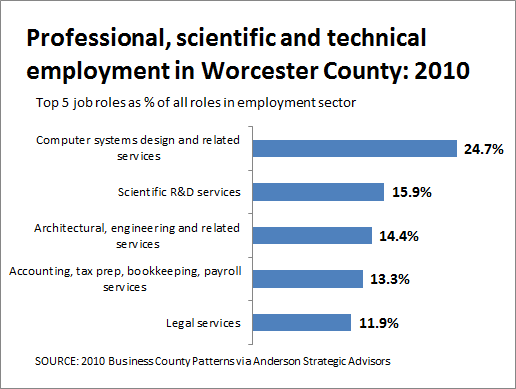A study commissioned by the Worcester Regional Chamber of Commerce says the city is in a strong position to attract new companies in the manufacturing, health, education, and science and technology industries because of its growing population and more innovation-based “industry clusters” in the area.
The report, the Worcester Regional Economic Competitiveness Outlook, calls Worcester an attractive option for companies looking to expand or relocate to the area.
The 38-page report, prepared by Anderson Strategic Advisors, calls Greater Worcester “an economic engine that has successfully recast its assets of the past while simultaneously growing strong clusters of innovation for the future.”
The report reinforces the goals being pursued by chamber president Timothy Murray, who was tasked with establishing the chamber as an economic development engine when he resigned as lieutenant governor to take the job.
“The study confirmed that we have a lot of existing assets to work with in our region, perhaps even more than some people realized, but we also have some work to do,” Murray said in a statement.
The study recommended that the chamber adopt three strategies to improve the “business friendliness” of the region and market its value to businesses considering a move to the area:
1. Expedite permitting and municipal best practices. The report suggested the chamber advocate for the adoption of six-month permitting on priority development sites, and implementation of a variety of best practices in economic development, such as online applications and designating a single point of contact for businesses.
2. Push tax incentives. The chamber is urged to encourage area cities and towns to consider utilizing tools such as tax incentive financing, which is already widely used, district improvement financing, and local research and development tax credits.
3. Network and attend trade shows. The report recommends a comprehensive business recruitment strategy that involves attendance at industry-specific trade shows, one-on-one pitch meetings with growing companies, and networking and participation with targeted industry groups.
Also, the report offered five areas for the chamber to emphasize in defining the region’s value:
1. Population growth. Between 2000 and 2010, Worcester experienced more growth in population and families than Boston or the commonwealth as a whole, the report said. Meanwhile, Worcester’s employment increased by twice that of the state, and the number of households earning $75,000 or more per year grew by 66 percent, according to the report.
2. Lower costs. Worcester’s real estate costs are less, on average, than Boston’s, the report said. In addition, workforce costs are lower and the cost of living is lower in Central Massachusetts than in Greater Boston.
3. Location, location, location. The report emphasized Worcester’s location in the center of the Bay State, within a one-hour drive of Boston, Hartford, Conn. and Providence, R.I. The report also touted the region’s accessibility to all of New England and its proximity to major airports in Boston, Hartford, Providence and Manchester, N.H.
4. Age and education level of workforce. In 2010, nearly a quarter of Worcester’s workforce fell in the 15-to-24 age bracket, and 84 percent of the workforce had greater than a high school education, with at least 30 percent holding a bachelor’s degree or higher, the report said. Also in 2010, both Worcester and Worcester County had higher concentrations of people up to age 14 than Boston or the state as a whole, the report noted, providing a larger volume of young workers that will enter the workforce over the next decade.
5. A thriving innovation economy. The report said that, between 2000 and 2010, Worcester County had 2.4 times as many people employed in manufacturing as Suffolk County. Moreover, employment in the scientific research and development subsector grew nearly 32 percent, while employment in the computer systems design and related services subsector, which includes digital game development, grew 46.3 percent.
The study also assessed property tax rates in the region and cited the chamber’s advocacy of a single tax rate in Worcester as a good way to spur economic growth. The city has a higher rate for business, but, due in part to the chamber’s advocacy, the gap between the residential and business rates has narrowed over the last two years.
“Aligning Worcester to a single tax rate is a strategic investment in our future,” Murray said. “The city needs to take aggressive action to invite new investment into the city. We know the fundamentals are there, but the policies need to catch up.”
Assumption College economics professor Thomas White, who last month launched a series of what are expected to be quarterly reports on the city’s economy, said in an email that tax rates and real estate costs are “important factors” influencing a firm’s decision of where to locate.
“However, the existence and quality of industry clusters is likely at least as important as differences in tax rates,” he wrote.
Although efforts to recruit new businesses are worthwhile, White said providing a climate that fosters innovation and expansion for those companies already here is also important.
Fund-raising goal reached early
Just weeks after taking over at the chamber, Murray launched a $1.2-million fund-raising campaign to help attract, grow and keep and businesses in the area. Murray said that money was raised within nine months, far ahead of its initial two-year goal. That, he said in a separate interview with the WBJ, “speaks to the commitment and support” the chamber received from the business community.
The city had previously tried to draw business from outside the area with the Choose Worcester campaign, which lasted only five years and ran out of money in 2010. But this time, Murray believes the chamber has a “sustainable model” to renew that effort.
“I think the chamber is the right place” to conduct such an initiative, he said, citing support from organizations such as the Worcester Business Development Corp. and Massachusetts Biotechnology Initiatives.
“We’re going to strike out more than we hit home runs,” he said. “But if we bat .300, we’re going to be OK.”
Read more

